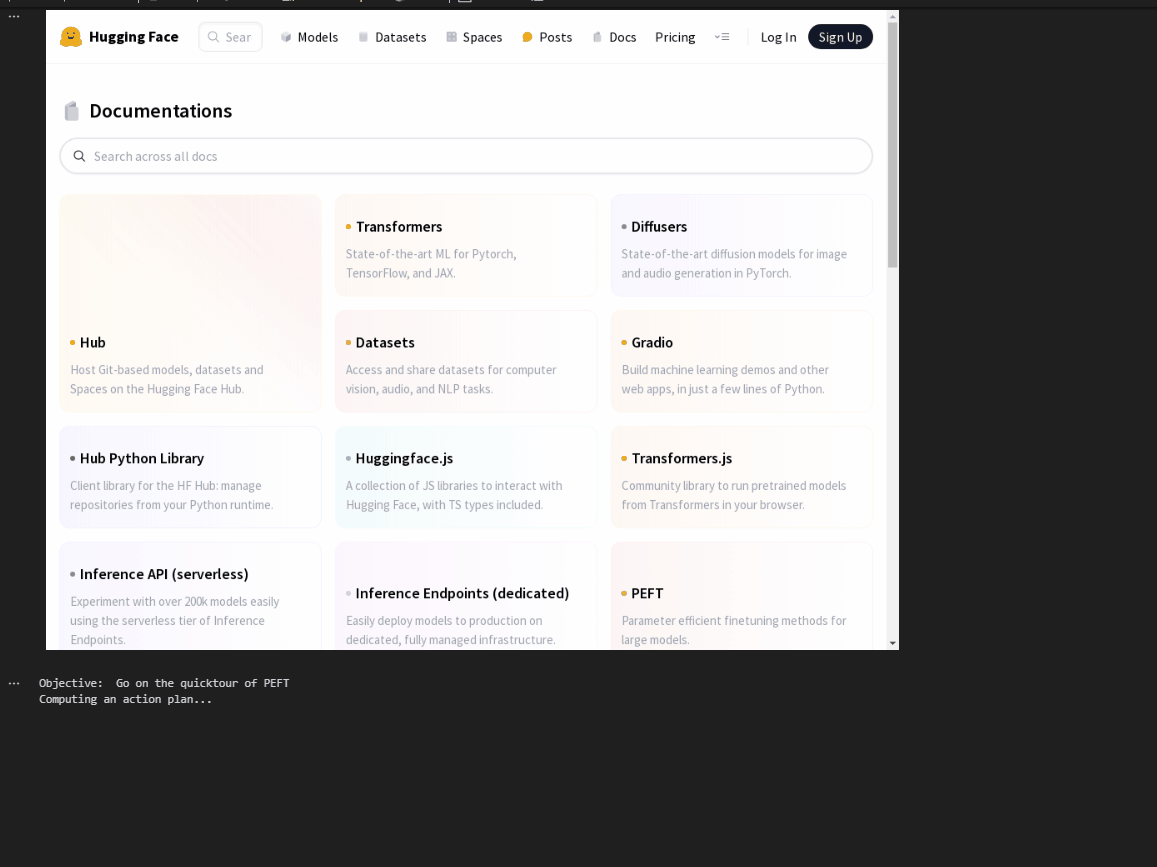LaVague is an open-source Large Action Model framework to develop AI Web Agents.
Our web agents take an objective, such as "Print installation steps for Hugging Face's Diffusers library" and performs the required actions to achieve this goal by leveraging our two core components:
- A World Model that takes an objective and the current state (aka the current web page) and turns that into instructions
- An Action Engine which “compiles” these instructions into action code, e.g. Selenium or Playwright & execute them
Here is an example of how LaVague can take multiple steps to achieve the objective of "Go on the quicktour of PEFT":
You can do this with the following steps:
- Download LaVague with:
pip install lavague- Use our framework to build a Web Agent and implement the objective:
from lavague.core import WorldModel, ActionEngine, PythonEngine
from lavague.core.agents import WebAgent
from lavague.drivers.selenium import SeleniumDriver
selenium_driver = SeleniumDriver(headless=False)
world_model = WorldModel()
action_engine = ActionEngine(selenium_driver)
python_engine = PythonEngine()
agent = WebAgent(world_model, action_engine, python_engine)
agent.get("https://huggingface.co/docs")
agent.run("Go on the quicktour of PEFT")For more information on this example and how to use LaVague, see our quick-tour.
Note, these examples use our default OpenAI API configuration and you will need to set the OPENAI_API_KEY variable in your local environment with a valid API key for these to work.
For an end-to-end example of LaVague in a Google Colab, see our quick-tour notebook
We would love your help and support on our quest to build a robust and reliable Large Action Model for web automation.
To avoid having multiple people working on the same things & being unable to merge your work, we have outlined the following contribution process:
- 📢 We outline tasks on our
backlog: we recommend you check out issues with thehelp-wantedlabels &good first issuelabels - 🙋♀️ If you are interested in working on one of these tasks, comment on the issue!
- 🤝 We will discuss with you and assign you the task with a
community assignedlabel - 💬 We will then be available to discuss this task with you
- ⬆️ You should submit your work as a PR
- ✅ We will review & merge your code or request changes/give feedback
Please check out our contributing guide for a more detailed guide.
If you want to ask questions, contribute, or have proposals, please come on our Discord to chat!
TO keep up to date with our project backlog here.
Note, this project executes LLM-generated code using exec. This is not considered a safe practice. We therefore recommend taking extra care when using LaVague and running LaVague in a sandboxed environment!
We want to build a dataset that can be used by the AI community to build better Large Action Models for better Web Agents. You can see our work so far on building community datasets on our BigAction HuggingFace page.
This is why LaVague collects the following user data telemetry by default:
- Version of LaVague installed
- Code generated for each web action step
- LLM used (i.e GPT4)
- Multi modal LLM used (i.e GPT4)
- Randomly generated anonymous user ID
- Whether you are using a CLI command or our library directly
- The instruction used/generated
- The objective used (if you are using the agent)
- The chain of thoughts (if you are using the agent)
- The interaction zone on the page (bounding box)
- The viewport size of your browser
- The URL you performed an action on
- Whether the action failed or succeeded
- Error message, where relevant
- The source nodes (chunks of HTML code retrieved from the web page to perform this action)
If you want to turn off all telemetry, you can set the TELEMETRY_VAR environment variable to "NONE".
If you are running LaVague locally in a Linux environment, you can persistently set this variable for your environment with the following steps:
- Add TELEMETRY_VAR="NONE" to your ~/.bashrc, ~/.bash_profile, or ~/.profile file (which file you have depends on your shell and its configuration)
- Use `source ~/.bashrc (or .bash_profile or .profile) to apply your modifications without having to log out and back in
In a notebook cell, you can use:
import os
os.environ['TELEMETRY_VAR'] = "NONE"






